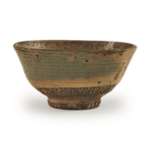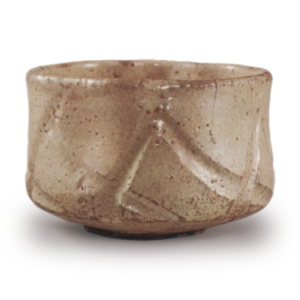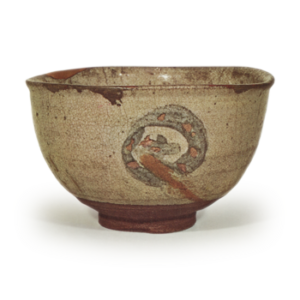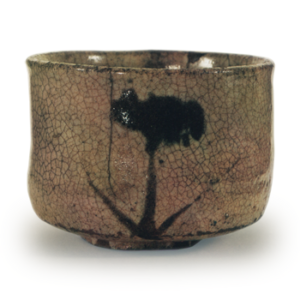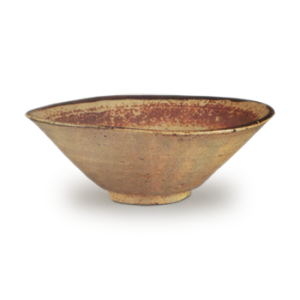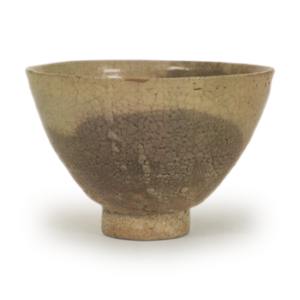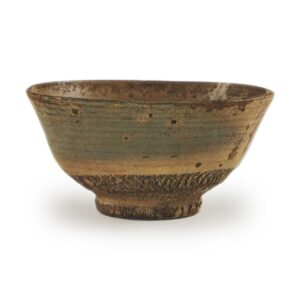
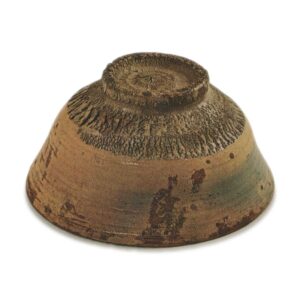
Height: 6.4-6.7cm
Diameter: 13.2-13.5cm
Outer diameter of foot ring: 5.4-5.5cm
Height: 1.0cm
Toto-ya tea bowls are the second most common type of Koryo tea bowl after Ido, and Takahashi Hoki-an, the compiler of the Taisho Meiki Kan, wrote: “Of the Korean tea bowls that exist in Japan, the number of Toto-ya tea bowls is second only to Ido, and when people in the general public say ‘tea bowl’, they immediately think of Toto-ya, so you can see how famous they are. However, the shape is generally bowl-shaped, and in terms of quality, it belongs to the second-rate of Korean tea bowls. This large number of bowls may be the main reason why famous bowls such as Kasumi did not appear until recent years. This “Kasumi” should also be classed as a so-called “honte” tea bowl, but the term “honte” as used by tea masters does not have a particularly deep meaning, and refers to a tea bowl with a deep bowl shape as opposed to a flat tea bowl, in other words, a tea bowl with a genuine bowl shape. Therefore, if we view the “Rikyu tea bowl” as a “honte” or “honga”, then this cannot be classed as a “honte” tea bowl either.
By the way, although it is also called a hontetsu totoya, it has a completely different feel compared to the Ryūta, and it makes me think again about how vague the classification of totoya tea bowls is. In the case of Ido, although the shape was different, there was a commonality in the glaze, called Ido glaze, but in the case of totoya, the glaze is also not consistent. Bokuan describes Totoya as a second-rate tea bowl in terms of quality, but this tea bowl is outstanding in terms of its high quality, and it can be said to be the most elegant of the three tea bowls in my limited knowledge. Even so, the workmanship is by no means weak, and the workmanship from the foot to the waist is rather fitting of the word “daring”.
The rather large foot ring is powerfully carved out to form a solid bamboo joint foot ring. The carving inside the foot ring is deep, and the whorl appears exactly centered on the helmet-shaped part, and the carving around the foot ring is also sharp. From there, the rim is boldly carved twice, and the waist is carved away, but because the clay was soft, the carving is very rough, giving it the appearance of a rugged rock. However, from the waist to the upper rim, the potter’s wheel marks are gently rounded, creating a calm appearance in contrast to the roughness of the rim. The body is slightly constricted around the middle and opens out slightly towards the rim.
In contrast to the raised lines on the outside, the inside is smooth and velvety, and the depth and size of the inside are quite large. However, the two clear lines of the potter’s wheel marks stand out beautifully at the waist, and this gives the impression that the entire depth of the piece is clean and light. The glaze is thin overall, but it is applied smoothly and evenly, and as usual, the color is a mixture of blue and yellow. The lower part of the vase is mostly yellow, but from the waist up, the color changes to a bluish-gray, as if a mist were drifting over one side, and there are speckles appearing on this side.
The inside is also of the same asymmetrical shape, but the glaze is unusually smooth and has the appearance of a glaze.
The words “Toya Kasumi” are written in gold powder on the lid of the black lacquered box, but the author is unable to make out the characters. The origin of the tea bowl in ancient times is completely unknown. According to what I have heard, it was originally owned by a temple in Osaka, and after the Pacific War, it was purchased by Shunkai, who then passed it on to Mitsui Takahiro, the head of the Muromachi Mitsui family. It is a tea bowl that has never been awarded a prize, but it is a famous bowl that has been hidden away in the world, and I wonder if this is because it was stored in a temple that had little connection to the world of tea.

